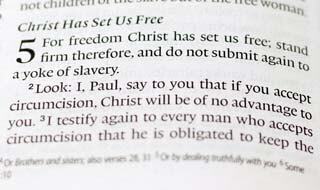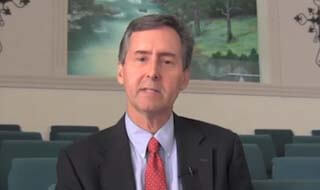The motion picture, The Passion of the Christ, presented an extremely vivid portrayal of Jesus Christ’s scourging and crucifixion. When the film was released, it was much discussed in the news and raised concerns about anti-Semitism. Sadly, Christendom’s history has been marred by the sinful persecution of Jewish people.
For example, Dr. Arnold Fruchtenbaum recalls a tragic episode from his childhood in Poland. A three-year-old child disappeared and church leaders accused the Jewish community for kidnapping him for a ritual murder: “This rumor was spread all over Poland and on the first night of Passover [1946] as we sat down to eat there were mobs forming in the streets outside … all over Poland violent mobs attacked Jewish ghettos, including the one that I was living in, and on that night … many Jews were killed in that name of Jesus Christ … Before they would kill any Jew they would shout in Polish the commonly heard line: ‘You killed Christ and so we will kill you.’ It was in those words that I first heard about Jesus.”[1] Therefore, one reason for anti-Semitism is blaming the Jews for the death of Christ.
Let’s reflect on this serious question: Who caused the death of Christ? A careful search of Scripture yields a nine-fold answer.
1. The physical cause: the Roman soldiers
If we start with the most immediate, direct cause of Christ’s crucifixion, we identify the hardened Roman soldiers. These soldiers mocked Him, using the opportunity to vent their animosity toward the Jews. “Then the soldiers led Him away into the hall called Praetorium, and they called together the whole garrison. And they clothed Him with purple; and they twisted a crown of thorns, put it on His head, and began to salute Him, ‘Hail, King of the Jews!’ Then they struck Him on the head with a reed and spat on Him; and bowing the knee, they worshiped Him. And when they had mocked Him, they took the purple off Him, put His own clothes on Him, and led Him out to crucify Him” (Mark 15:16-20).
After scourging Him, they led Him away to Calvary. There they nailed His blessed hands and feet to the Cross (Matt. 26:33-36; John 20:25). As darkness covered the sky over Jerusalem like sackcloth, even the Roman centurion acknowledged the supernatural dignity and love of this King of the Jews: “So when the centurion and those with him, who were guarding Jesus, saw the earthquake and the things that had happened, they feared greatly, saying, ‘Truly this was the Son of God!'” (Matt. 27:54). However, the Roman soldiers were not the only cause of Christ’s death…
2. The executive legal cause: the Roman governor, Pilate
It’s ironic that history’s only memory of Pilate involves the Jewish blood that he shed (Luke 13:1) and his sentencing of Jesus to the Cross. Pilate was warned. His wife sent him an ominous message: “Have nothing to do with that just Man, for I have suffered many things today in a dream because of Him” (Matt. 27:19). Readers of the Gospels are familiar with His pronouncement: “I find no fault in Him.” The private conversations with Christ pending the verdict are profound (John 18:28-19:11). Pilate tried to appease the mob by offering to release Christ according to his Passover tradition, but to no avail. Finally he heard from the crowd, “If you let this Man go, you are not Caesar’s friend. Whoever makes himself a king speaks against Caesar” (John 19:12). Then he made the infamous choice to value his career more than justice. Although he ceremonially washed his hands, he could not absolve himself of judicial murder. However, Pilate was not alone in causing Christ’s crucifixion…
3. The passive legal cause: King Herod Antipas
When governor Pilate was looking for a way to evade his judicial responsibility concerning Jesus, he thought of King Herod: “…as soon as [Pilate] knew that [Jesus] belonged to Herod’s jurisdiction [Galilee], he sent Him to Herod, who was also in Jerusalem at that time. Now when Herod saw Jesus, he was exceedingly glad; for he had desired for a long time to see Him, because he had heard many things about Him, and he hoped to see some miracle done by Him” (Luke 23:6-8). (This is the same Herod who murdered the herald of Christ—John the Baptist, Mark 6:20-25). Since Herod was not interested in truth, but merely wanted to be entertained by a miracle, Christ did not answer the king’s probes (Luke 23:9). So the king treated the true King with ridicule: “Then Herod, with his men of war, treated Him with contempt and mocked Him, arrayed Him in a gorgeous robe, and sent Him back to Pilate” (Luke 23:11). Herod could have pardoned Christ, since Jesus was from Nazareth—a town under Herod’s jurisdiction, but Antipas forfeited his responsibility and became passively culpable in Christ’s death. Instead of finding reconciliation with God, Herod became friends that day with governor Pilate (Luke 23:12). However, Herod was not alone in causing Christ’s death…
4. The primary legal cause: the Sanhedrin
The Jewish ruling council, the Sanhedrin, was made up of leading Sadducees and Pharisees of Israel. The current high priest functioned as president. John’s Gospel indicates that the high priest conspired to have Christ arrested and brought in from the Garden of Gethsemane. Although Annas was deposed from the office of high priest by the Romans, he still functioned with similar authority. He was the father-in-law of the current high priest (John 18:14). When an attendant objected to an answer Christ gave in his preliminary Jewish trial, he illegally stuck Jesus in the face (John 18:22). “Then Annas sent [Christ] bound to Caiaphas the high priest” (John 18:24).
Although it was illegal for the Sanhedrin to meet at night to try a capital case on the eve of Passover—and to decide prior to the final trial that Jesus would be killed (John 11:53)—they proceeded with the second part of the Jewish trial.[2] False witnesses were summoned but even their testimony would not agree. Finally, Caiaphas declared: “‘Do You answer nothing? What is it these men testify against You?’ But He kept silent and answered nothing. Again the high priest asked Him, saying to Him, ‘Are You the Christ, the Son of the Blessed?’ Jesus said, ‘I am. And you will see the Son of Man sitting at the right hand of the Power, and coming with the clouds of heaven.’ Then the high priest tore his clothes and said, ‘What further need do we have of witnesses? You have heard the blasphemy! What do you think?’ And they all condemned Him to be deserving of death. Then some began to spit on Him, and to blindfold Him, and to beat Him, and to say to Him, ‘Prophesy!’ And the officers struck Him with the palms of their hands” (Mark 14:60-65). Since they had no legal right to execute anyone under Roman rule, they sent Jesus to Pilate for enforce their verdict of capital punishment. Over 900 years earlier, David prophetically described the details of Messiah’s crucifixion (Psalm 22:1-21)!
So, the Jewish leaders of that generation had a pivotal role in the arrest, condemnation, and sentencing of Jesus. Clearly, but not every member voted for this travesty of justice. Nicodemus and Joseph of Arimathea came forward to demonstrate their faith in Christ by burying Him with dignity (John 19:38-42).
The majority of the nation heard Jesus Christ gladly and believed His miracles. Just a few days prior to this secretive trial a representative throng celebrated His triumphal entry into Jerusalem. The Sanhedrin’s culpability in no way allows anyone to blame the Jews (as a race) for Christ’s death. Christ and the apostles were also Jews, as was the majority of the church in the opening chapters of the book of Acts. Christians are to share the gospel with sons of Abraham and honor the heritage of this chosen people who were used of God to record the Holy Bible (2 Pet. 1:19-21). Like Paul, our heart’s desire and prayer for Israel is for their salvation (Rom. 10:1). We look forward to the day when this people will recognize the significance of Messiah’s sacrifice (Zech. 12:10) and be grafted back in to the olive tree of redemption (Rom. 11:17-32).
(Part 1 of 2)
[1] “A Personal Testimony,” p. 6. By God’s amazing grace, Dr. Fruchtenbaum later received Jesus as his personal Messiah and Savior. He serves as author and teacher with Ariel Ministries (www.Ariel .org). His testimony is available in booklet and cassette form.
[2] Geneva Study Bible note at John 18:13, referring to the Mishna.
Part 2 is archived at https://gracenotebook.com/who-caused-the-death-of-christ-part-2/
Grace Notes © 2004 by John Woodward. Permission is granted to reprint this article for non-commercial use if credit is given to the author and GraceNotebook.com. Scripture quotations are from The Holy Bible, New King James Version © 1982 by Thomas Nelson, Inc.

















